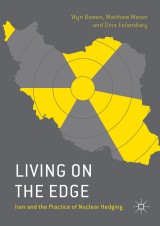Details

Living on the Edge
Iran and the Practice of Nuclear Hedging|
96,29 € |
|
| Verlag: | Palgrave Macmillan |
| Format: | |
| Veröffentl.: | 08.06.2016 |
| ISBN/EAN: | 9781137273093 |
| Sprache: | englisch |
Dieses eBook enthält ein Wasserzeichen.
Beschreibungen
<p>In this book, the authors explore the controversial Iranian nuclear
programme through the conceptual lens of nuclear hedging.</p>
<p>In 2002, revelations regarding undeclared nuclear facilities thrust
Iran’s nuclear activities under the spotlight and prompted concerns that
Tehran was pursuing nuclear weapons. Iran has always denied nuclear weapons
aspirations, yet it cannot be disputed that the Islamic Republic has gone well
beyond what is required for a civil nuclear programme based on energy
production and scientific research. </p>
<p>What, then, is the nature and significance of Iran's nuclear behaviour?
Does it form part of a coherent strategy? What can Iran's actions in the
nuclear field tell us about Tehran's intentions? And what does the Iranian
case teach us about proliferation behaviour more generally? </p><p>This book addresses these
questions by exploring the nature of nuclear hedging and how this approach
might be identified, before applying this logic to the Iranian case. It
provides fresh insights into the inherently opaque area of nuclear
proliferation and a more nuanced interpretation of the Iranian nuclear
challenge.</p>
programme through the conceptual lens of nuclear hedging.</p>
<p>In 2002, revelations regarding undeclared nuclear facilities thrust
Iran’s nuclear activities under the spotlight and prompted concerns that
Tehran was pursuing nuclear weapons. Iran has always denied nuclear weapons
aspirations, yet it cannot be disputed that the Islamic Republic has gone well
beyond what is required for a civil nuclear programme based on energy
production and scientific research. </p>
<p>What, then, is the nature and significance of Iran's nuclear behaviour?
Does it form part of a coherent strategy? What can Iran's actions in the
nuclear field tell us about Tehran's intentions? And what does the Iranian
case teach us about proliferation behaviour more generally? </p><p>This book addresses these
questions by exploring the nature of nuclear hedging and how this approach
might be identified, before applying this logic to the Iranian case. It
provides fresh insights into the inherently opaque area of nuclear
proliferation and a more nuanced interpretation of the Iranian nuclear
challenge.</p>
<p><i>About the Authors.- </i><i>Acknowledgements</i><i>.- </i><i>Abbreviations and Acronyms</i><i>.- </i><i>Chronology of Events</i><i>.-</i>Introduction: Understanding Iranian Proliferation Behaviour<i>.- </i>Chapter 1: The Nature of Nuclear Hedging<i>.- </i>Chapter 2: Opaque Proliferation and Moves Towards Latency<i>.- </i>Chapter 3: Narrating a Nuclear Programme<i>.- </i>Chapter 4: Playing for Time? Iran’s Nuclear
Diplomacy<i>.- </i>Chapter 5: Rouhani’s Redirection: The End of Iranian
Hedging?<i>.- </i>Chapter 6: Living with nuclear hedging<i>.- </i>Conclusion: Latency With Intent<i>.- Bi</i><i>bliography</i><i>.- </i><i>Annex 1: Comprehensive
Joint Plan of Action</i><i>.- </i><i>Index.</i></p>
Diplomacy<i>.- </i>Chapter 5: Rouhani’s Redirection: The End of Iranian
Hedging?<i>.- </i>Chapter 6: Living with nuclear hedging<i>.- </i>Conclusion: Latency With Intent<i>.- Bi</i><i>bliography</i><i>.- </i><i>Annex 1: Comprehensive
Joint Plan of Action</i><i>.- </i><i>Index.</i></p>
<p>Wyn Bowen is Professor of Non-proliferation and International Security
and Head of Department at the Defence Studies Department at King’s College
London, UK.</p><p>Matthew Moran is Senior Lecturer in International Security in the
Department of War Studies at King’s College London, UK.</p>
<p>Dina Esfandiary is a MacArthur Fellow at the Centre for Science and
Security Studies at King’s College London, UK.<br></p>
<p> </p>
and Head of Department at the Defence Studies Department at King’s College
London, UK.</p><p>Matthew Moran is Senior Lecturer in International Security in the
Department of War Studies at King’s College London, UK.</p>
<p>Dina Esfandiary is a MacArthur Fellow at the Centre for Science and
Security Studies at King’s College London, UK.<br></p>
<p> </p>
<p>In this book, the authors explore the controversial Iranian nuclear programme through the conceptual lens of nuclear hedging.</p><p>In 2002, revelations regarding undeclared nuclear facilities thrust Iran’s nuclear activities under the spotlight and prompted concerns that Tehran was pursuing nuclear weapons. Iran has always denied nuclear weapons aspirations, yet it cannot be disputed that the Islamic Republic has gone well beyond what is required for a civil nuclear programme based on energy production and scientific research. </p><p>What, then, is the nature and significance of Iran's nuclear behaviour? Does it form part of a coherent strategy? What can Iran's actions in the nuclear field tell us about Tehran's intentions? And what does the Iranian case teach us about proliferation behaviour more generally? </p><p>This book addresses these questions by exploring the nature of nuclear hedging and how this approach might be identified, before applying this logic to the Iranian case. It provides fresh insights into the inherently opaque area of nuclear proliferation and a more nuanced interpretation of the Iranian nuclear challenge.</p>
Diese Produkte könnten Sie auch interessieren:

Herausforderungen und Chancen eines künstlerischen Wettbewerbs für ein Mahnmal in Gedenken an die Opfer des 19. Februar 2020 in Hanau

von: Katharina Meyer zu Eppendorf

29,99 €

Der erste arabisch-israelische Krieg und seine Folgen für die Palästinenser

von: Dean Sánchez Pedregoso

15,99 €














